Behind the Scenes: The House of Commons Administration
Major-General Maurice Gaston Cloutier (1935-2005)
The House of Commons lost its longest-serving
Sergeant-at-Arms last year with the passing of
Major-General M.G. "Gus" Cloutier. General Cloutier
joined the House following a distinguished career in
the Canadian Armed Forces and, for 27 years, performed
the duties of his office with dignity, courtesy and a
sense of humour. As Sergeant-at-Arms, he was
responsible for security and building services and all
ceremonial aspects of House tradition, of which the
most public duty was to shoulder the ceremonial Mace
during processions to and from the Commons Chamber.
General Cloutier also served as Canadian Secretary to
Her Majesty The Queen, coordinating her visits to
Canada in 1994, 1997 and 2005 as well as her Golden
Jubilee of 2002. He was respected throughout Canada's
Parliament and is sorely missed.
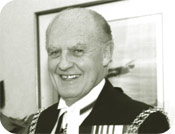
General Cloutier.
Table Research Branch Celebrates 25th Anniversary
In 2005, the Table Research Branch of the House
Administration marked its 25th anniversary. Established
by the late Dr. C.B. Koester, former Clerk of the House
of Commons, the Branch is the focal point for
procedural expertise and advice, and produces
publications, training and information for Members of
Parliament, House staff and other wider audiences.
Supporting Members of Parliament
Whether they are working on legislative issues on
Parliament Hill, talking with constituents in their
riding, or meeting with other legislators abroad,
Members of Parliament are supported in their work by
the staff of the House of Commons Administration.
The House of Commons Administration is made up of five
Service Areas: Procedural Services; the Office of the
Law Clerk and Parliamentary Counsel; Information
Services, Parliamentary Precinct Services; and Corporate
Services. These areas, which draw on the equivalent of
some 1,737 full-time employees, are accountable to the
Clerk of the House of Commons, who reports to the
Speaker, and serves as Secretary to the Board of Internal
Economy. The first woman to serve as Clerk of the House
of Commons, Audrey O'Brien, was appointed in October 2005
following a review of her nomination by a standing
committee and a ratification vote in the House. Ms.
O'Brien succeeded William C. Corbett, who retired after
26 years of dedicated service to the House.
The
Board of Internal Economy governs the House
Administration. The Board is chaired by the Speaker and
made up of
Members from all recognized political parties. It is
responsible for all matters of financial and
administrative policy affecting the House of Commons.
Strategic Objectives
In the
Strategic Outlook for the 38th Parliament, the
House of Commons Administration presented four main
objectives that reflect its vision, values and mandate,
and provide a framework for its activities in support of
Members. These objectives are as follows:
-
Respond to the evolving role of Members
-
Enhance ongoing services to Members and sustain the
institution
-
Promote understanding and support the advancement of
legislative institutions
-
Apply the highest standards of public-sector governance
in a parliamentary context
The following sections highlight the House
Administration's key accomplishments achieved under these
objectives in 2005-2006, and commitments for 2006-2007.
I. Responding to the Evolving Role of Members
While the institution is over a century old, the House of
Commons is constantly evolving to meet the demands of a
modern society by introducing new ways of conducting its
activities, and connecting citizens to the work of
Parliament. The House of Commons Administration supports
this work by responding to the needs of Members of
Parliament, providing new tools, refining procedures and
making the most of new technologies.
Supporting the Evolution of Parliamentary Practices and
Rules
-
Many of the rules by which the House of Commons
operates were adopted in an era of majority
governments. The 38th Parliament was the first to have
a minority government in over 25 years, and many of
these rules were put to the test in this environment.
The House Administration provided support and advice in
applying the existing rules in new circumstances, and
in drafting and implementing further changes to the
Standing Orders. This support will continue to be
provided in the 39th Parliament, which also has a
minority government.
Ensuring a Flexible Technology Infrastructure

Newly elected Members attend orientation sessions where
they learn about their roles and the services provided
by the House Administration to support them in their
work.
Photo: © C. Diotte
parliamentary heritage
Got the Blues?
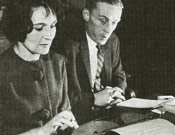
For many years, proceedings were typed on carbon
sets for distribution to the printer, translation
services, the press and Members. The copies sent to
Cabinet Ministers and parliamentary secretaries after
they had spoken in the Chamber were on blue paper,
which is why the draft debates are still commonly
referred to as the blues.
There are also the less well-known yellows, the
reporters' copy from the French debates office; the
greens, the English reporters' copy forwarded to the
Press Gallery; and the whites, the final
edited Hansard.

-
The Administration continued to ensure a responsive,
robust and secure technology environment by
-
selecting a tool for managing video and audio
assets of Chamber and committee proceedings;
-
upgrading the cabling, monitoring and control
systems in the Chamber broadcast control room;
-
planning and implementing information technology
services and infrastructure as part of the
Long-Term Renovation Program for Parliament Hill;
and
-
providing underground connectivity with buildings
located on either side of Wellington Street, where
Parliament's main buildings are located.
Improving Members' Access to Parliamentary Information
-
Work proceeded on the development of "Today in the
House," a Web site that will provide Members of
Parliament, staff and the public with a central access
point for information about the daily proceedings of
the House of Commons. The House Administration will
launch the initial phase of this site in 2006-2007.
-
The House Administration, with its partners in the
Senate, the Library of Parliament, and Public Works and
Government Services Canada, created the
Parliamentary Information Services Vision and
Strategy, a critical first step in defining a
collaborative approach to information management and
enabling these institutions to work more closely for
the benefit of parliamentarians, their staff and the
public. Over the coming year, a new governance
structure will be implemented for sharing this
information.
Involving Canadians in the Parliamentary Process
-
The House Administration introduced new features for
the
House of Commons Committees Web site to give users
better access to committee reports, contact information
and further details about the work of committees.
-
An e-consultation toolkit was also piloted by the
Standing Committee on Foreign Affairs and International
Trade and will be introduced to committees at the
beginning of the 39th Parliament. The toolkit is a
platform of basic electronic consultation tools that
have been developed to help committees wishing to use
the Internet to consult Canadians.
II. Enhancing Ongoing Services to Members and Sustaining
the Institution
One of the essential roles of the House Administration is
to sustain the institution by improving the basic
services and support systems required to meet Members'
needs, and to provide the public with secure and
appropriate access to these important national buildings.
Over the past year, its activities in this regard have
included planning for construction and emergency
relocation, and producing documents and seminars to
increase knowledge of parliamentary issues.
Renovating the Parliament Buildings
-
The House Administration contributed to the update of
the
Long-Term Vision and Plan for the Parliamentary
Precinct and to the related implementation
strategy. The plan sets out a program of major new
construction and renovation work and was revised in
response to new priorities.
-
Renovations to the West Block commenced, as did plans
for relocating occupants to allow major construction
work to proceed. Interim accommodations will be
developed for the relocation of all West Block
functions over the next few years.
-
In partnership with Public Works and Government
Services Canada, the Administration continued to
oversee the planning, design and installation of
facilities, infrastructure and information technologies
to support the relocation of Members of Parliament
their staff and parliamentary functions.
Improving Information Technology Services
parliamentary heritage
On Time, Every Time
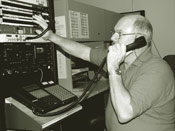
After the debates have concluded, sometimes
already late in the evening, work continues through
the night so that Hansard is available by
9:00 a.m. the next morning.
The transeditors change audio into text that is
then edited, translated and proofread. The Publishing
and Quality Assurance Officer oversees the process
and makes the text available electronically.
The 9:00 a.m. deadline has consistently been met
with dedication and precision, first by the Official
Debates Reporting Branch, and now by Parliamentary
Publications.

-
The House Administration is finalizing a new electronic
form for purchasing office supplies in the constituency
that will provide more timely service to Members.
Implementation will occur in the upcoming fiscal year.
-
The House Administration continued to refine its
technology systems to improve the management of
financial and human resources information and better
support Members and the House Administration.
-
Sustainable approaches and technologies to support
real-time closed-captioning of proceedings were
assessed, and the appropriate technology will be
selected in the next fiscal year.
Refining the Business Continuity and Resumption Plan for
the House of Commons
-
The House Administration refined its Business
Continuity and Resumption Plan to ensure that
Parliament can readily relocate and resume its
activities in case of emergency. Alternate sites for
relocation were identified, and threat, risk and impact
analyses were conducted for certain sites. Relocation
plans and strategies were also developed for Chamber
and constituency activities.
Sustaining the Institution and Improving Services
-
Through the Election Readiness Program, the House
Administration and the Library of Parliament provided
new, returning and departing Members with services in
the period surrounding the dissolution of the 38th
Parliament and the opening of the 39th Parliament.
Initiatives included a Web site concerning services to
Members, a toll-free hotline, an information centre and
service fair, and orientation sessions on
administrative and procedural services. In the two
months following the election, the information centre
received over 674 visitors, and the telephone hotline
responded to 1,393 requests.
-
The House Administration developed documents on a range
of parliamentary matters. For example, a guide to
parliamentary associations was developed for
association chairs; a new version of the
House of Commons Standing Orders was
introduced, highlighting provisional sections for easy
reference; and e-versions of the
Practical Guide for Committees, the
Glossary of Parliamentary Procedure, and the
Practical Guide for Private Members' Business
were all updated.
-
Throughout the past year, the House Administration and
the Library of Parliament offered seminars to Members
and their staff on various procedural subjects, such as
the legislative process, financial procedures, and work
in committees as well as in the Chamber. In the coming
fiscal year, the Administration and Library will
continue to support Members and their staff through
seminars on such topics as Private Members' Business.
III. Promoting Understanding and Supporting the
Advancement of Legislative Institutions
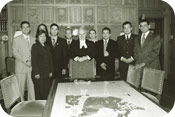
Speaker Milliken welcomes participants to the
Parliamentary Officers' Study Program, November 2005.
Photo: © K. Rodier
The House of Commons Administration supports Members of
Parliament as they promote a greater understanding of
Canada's parliamentary institutions. These activities can
range from producing authoritative works on the House of
Commons, to sharing the beauty of the Parliament
Buildings via the Web. The Administration also provides
valuable support to Members as they work with other
legislatures around the world, sharing ideas and
experiences with their counterparts, and helping existing
and emerging legislative institutions.
Updating Major Publications on Parliamentary Procedure
-
To continue to offer the public searchable access to
essential procedural reference works, the House of
Commons Administration updated or made available online
a number of key documents which explain the procedures,
history and traditions of the House of Commons.
-
The first edition of
House of Commons Procedure and Practice -
also known as
Marleau-Montpetit after its authors - was
launched on the Parliament of Canada Web site.
Planning and research will proceed on a second
edition in the coming year.
-
Designed especially for the Internet, the
Compendium of Parliamentary Procedure
(which replaced the Précis of Procedure)
was published and explains how the House and its
committees function.
-
Work was completed on the second edition of the
Annotated Standing Orders, which provide
commentary and a historical summary for each of the
Standing Orders - the written rules of the House of
Commons. A Web version of this publication will be
launched in 2006-2007.
Parliament by the Book
Several publications were produced in print and
online to explain the work of the House of Commons and
Parliament to Canadians:
House of Commons Procedure and Practice
Compendium of Parliamentary Procedure
Annotated Standing Orders
Providing Learning Opportunities for Parliamentarians and
Officials from Canada and Abroad
-
In partnership with the Senate of Canada and the
Library of Parliament, the House Administration
continued to offer its Parliamentary Officers' Study
Program for senior parliamentary staff from other
legislatures. In addition to English and French
seminars, and in response to an increased level of
cooperation within the Americas, the Parliament of
Canada invited Brazil and the Spanish-speaking
countries of the
Inter-Parliamentary Forum of the Americas (FIPA) to
participate in a special Spanish program in late
October 2005.
-
The legislatures of Brazil, Colombia, Costa Rica,
Mexico, Paraguay, Peru and Uruguay sent representatives
to learn about the Canadian parliamentary system and
discuss common challenges that parliamentary officers
face. A special session of the Parliamentary Officers'
Study Program will be held in 2006 for representatives
of the new Afghan parliament.
-
In August 2005, the Clerk of the Senate and the Clerk
of the House of Commons co-chaired the 2005
Professional Development Seminar of the Association of
Clerks-at-the-Table, enabling Association members to
increase their knowledge of the parliamentary system
and procedure in Canada, and share best
practices.
Sixty-five federal, provincial and territorial
Clerks-at-the-Table attended, as well as several Clerks
from Australia, the United States, the United Kingdom,
Northern Ireland and Scotland.
-
From September 11 to 15, 2005, the Senate and the House
of Commons hosted the 5th Annual Conference of the
Canadian Association of Parliamentary Administration
(CAPA). CAPA is a network for senior officers
responsible for parliamentary administration in all
Canadian parliaments. Members of CAPA provide services
and direction in areas of administration, finance,
human resources and information technology. The
Conference held on Parliament Hill provided a unique
forum for the participants to exchange information and
share knowledge and practices related to parliamentary
services.
parliamentary heritage
Technological Growth
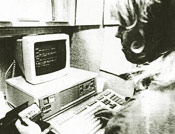
The technology used to capture the proceedings
changed very little until the mid-1980s. Reporters
wrote in shorthand and then dictated their notes for
transcription after leaving the Chamber.
The ability to record to cassette and transcribe
to diskette were the first steps in a huge
technological revolution. Transcribers were soon able
to save to a network, eliminating the need for
hundreds of diskettes per day. Cassettes were later
abandoned when Hansard staff were able to
access digital audio recordings of the Chamber from
their personal computers.
In 2001, the House of Commons launched PRISM, a
system capable of managing all aspects of information
publishing, from the capture of the spoken word to
the distribution of Hansard itself.

Sharing Parliament's Heritage with Canadians
-
The House Administration launched the
Heritage Collection Web site in the fall of 2005 to
give Canadians easy access to authoritative information
on the art, architecture and artefacts of Parliament.
Heritage profiles of sculptures, ironwork and other
features will be added to the site on an ongoing basis.
-
To support the Year of the Veteran and to highlight a
less well-known feature of the Parliament Buildings,
the House Administration created a Web site profiling
the Memorial
Chamber. Launched in December 2005, the site offers
a virtual tour of this serene yet stunning room which
honours people who died in military service throughout
Canada's history.
IV. Applying the Highest Standards of Public-Sector
Governance in a Parliamentary Context
The House of Commons implements best practices and
effective management processes, and promotes the
responsible stewardship of its resources as part of its
ongoing efforts to ensure its accountability and
transparency to Canadians.
Keeping the House of Commons Secure
-
The House Administration improved security by
strengthening communications and integrating security
activities with its partners in the Senate of Canada
and the Royal Canadian Mounted Police. In cooperation
with the Senate Protective Services, the Administration
introduced a common identification card for the
Parliamentary Precinct. This identification card
promotes ease of accessibility with enhanced security
features. Upcoming security initiatives in 2006-2007
include "Security is Everybody's Business," a strategy
to increase employees' awareness of security issues.
Strengthening the House of Commons Management Practices
-
In the past fiscal year, audit, evaluation and review
activities focused on election preparedness, the credit
card policy, environmental compliance and contracting.
As well, the
House Administration's financial statements for
2004-2005 were audited. In 2006-2007, emphasis will
be placed on the management of risks related to
contracting and financial practices, both of which are
now annual activities. Other upcoming assessments
include conflict resolution, human resource data,
business continuity management and the application of
various policies.
-
As part of a multi-year policy framework, the House
Administration reviewed or began developing policies on
such subjects as managing conflict of interest,
classification, and accommodating employee needs to
foster the full participation of all persons in the
workplace. Policy activities in 2006-2007 will focus on
employment equity and contracting.
-
Recognizing the need for a life-cycle approach to
managing its assets and ensuring their sustainability,
the House Administration began the development of an
asset management strategy.
parliamentary heritage
Worth a Thousand Words
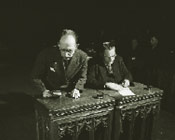
Imagine using handwritten or machine shorthand to
write over 200 words per minute and record four
Members speaking at once. Parliamentary reporters
could keep up that pace without even raising their
heads to see who was speaking. A tape recorder could
not capture all the voices clearly or distinguish the
speakers.
During the first 110 years of Hansard
reporting, reporters served 80-minute rotations:
10 minutes in the Chamber and 70 minutes outside the
Chamber to sub-edit and dictate their notes, ensure
the correct spelling of proper names and confirm the
accuracy of quotations. Amazingly, teams of one
French reporter and one English reporter could
capture everything that was said in the Commons.

Managing Parliamentary Information and Information
Technology Assets
-
The House of Commons Administration developed new
methods of using technology to track key information on
parliamentary associations and their membership.
Software will be employed to produce reports for
tabling in the Senate and the House of Commons, and for
publishing on the Web.
-
Using the Members' Allowances and Services
Manual as a test case, the House Administration
piloted software that allows it to update online
information quickly and easily, and provide users with
accurate and reliable data.
-
The House Administration developed tools to manage and
share critical information throughout the House of
Commons, with parliamentary partners and through the
Internet. These tools will enable information to be
collected once and reused in many formats and
publications, thereby preventing duplication of effort
and ensuring greater accuracy of the information
published. Initiatives included creating a "best
practices" group to ensure publication standards;
improving methods to track the use of time in the
Chamber; and developing a consistent set of common
terminology for storing, retrieving and managing
procedural information.
-
To give participants easy online access to registration
and conference information, enhancements were made to
Web sites for two major international conferences to be
hosted next year by the Parliament of Canada: the 12th
General Assembly of the Asia-Pacific Parliamentary
Conference on Environment and Development, and the
52nd Annual Session of the NATO Parliamentary
Assembly.
Sustaining a Motivated and Effective Workforce
-
As a pro-active measure to address the expected
increase in retirement rates over the next few years,
the House Administration continued to refine and
introduce new human resources practices to ensure that
it can maintain a highly skilled and motivated
workforce. Competency profiles will continue to be
introduced for all positions for the purposes of
staffing and evaluation.
-
In keeping with its human resources management
strategy, the Administration developed an employment
equity plan, which will be implemented in 2006-2007,
and conducted developmental work to establish a
conflict management resolution program.
-
In addition to developing policies on occupational
health and safety, and accident prevention programs,
both of which will be implemented in the coming fiscal
year, the House Administration undertook new
initiatives to foster a healthy and safe work
environment. These initiatives included monthly
sessions on health-related topics, vaccination and
blood pressure clinics, the introduction of fitness
classes, and a health-risk assessment pilot.
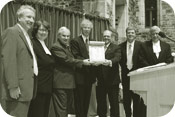
Former Environment Minister Stéphane Dion presents an
environmental award to representatives of the Partners
for a Green Hill program.
Photo: © C. Diotte
parliamentary heritage
Duty and Disaster
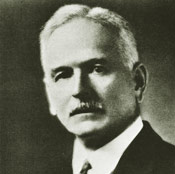
At approximately 9:00 p.m. on February 3, 1916,
Members were in the Chamber, discussing the problem
of transporting fresh fish.
The Hansard for that day notes a sudden
interruption: "Mr. C.R. Stewart, Chief Doorkeeper of
the House of Commons, came hurriedly into the Chamber
and called out "There is a big fire in the reading
room; everybody get out quickly'."
This dramatic moment was captured in the Debates
because George Simpson, the loyal parliamentary
reporter on duty, wrote it down and remained at his
desk until the Speaker had left the Chamber. He then
left himself, notebook in hand. That night at a
nearby hotel, he dictated the events, and sent the
text to the King's Printer like any other night.

Improving Environmental Management on the Hill
-
In June 2005, the first environmental awards ceremony
involving the four institutions in the
Partners for a Green Hill program (the Senate, the
House of Commons, the Library of Parliament, and Public
Works and Government Services) was held. The partners
also received the Canadian Council of Ministers for the
Environment 2005 Pollution Prevention Award.
-
A chemical products review identified 15 cleaning
products that can be replaced by one environmentally
friendly option, thereby reducing the risk of chemical
exposure and the accidental mixing of incompatible
products. The Administration also expanded the paper
towel composting program by implementing the
recommendations of the Annual Waste Audit.
-
Also initiated were a transit pass program allowing
employees to purchase their bus pass through payroll
deductions, and a Web-based carpooling program.












